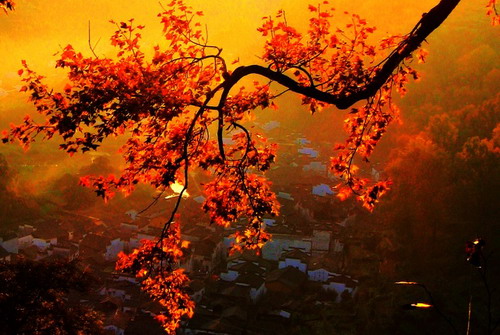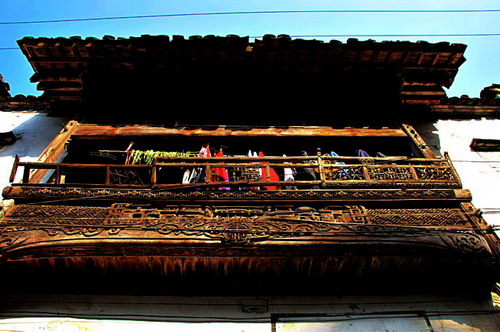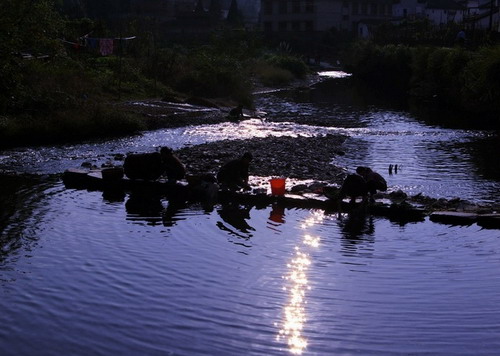Lofty Lushan Mountain
Temples in Hidden Places
On the First of August
Wheels by the Water
Share your travel story with regional@chinadaily.com.cn
A picturesque village to remember
( chinadaily.com.cn )
Updated: 2011-10-27
 |
| Changxi village in fall |
Our off-road vehicle bumped along the mountain road towards Changxi village. I was absorbed in fancying about the destination of the trip. I had passed by Wuyuan a number of times, and yet had little impression as I took only a peek at the county in the Yangtze River Delta. A few days ago, some friends of mine invited me to tour Changxi, a village so much out of the way; it is unknown to many local residents of Wuyuan. I bowed down to my intense inner desire to take a trip. Without much thought, I packed up and I was in Wuyuan.
All the way, I saw towering ancient trees and heard fair-sounding bird tweets. The fine views looked reassuring. Ridges and peaks rose one after another in the distance. Once in a while, we saw farmers carrying choppers on the back, going forward with firm footsteps. Our vehicle drove forward around 10 kilometers and we saw quiet villages attended by ancient trees and mountains. Smoke rose from grey kitchen chimneys…. It resembled a scroll painting typical of regions south of the Yangtze River.
We finally arrived at Changxi village. A stone bridge stood erect at the entrance. We got off the vehicle and walked forward. The lanes were lined with age-old houses, whose overhanging eaves were covered with green mosses. Dai Xiangyang, the village head, came to meet us. He told us his village was set up in 992 during the Song Dynasty (960-1279), so it was over 1,000 years old. Dai, full of courage, never paused to tell us about the ins and outs of the village. He was indeed fond of his hometown.
Dai was a fan of photography. A native of the village, Dai knew well the cultural history and bright spots of Changxi. He designed time-saving and economical routing of travels for many tourists to the village. He solved practical problems to nearly 100,000 tourists over the years. It was curious to find every visitor was looking for Dai in the village. They would ask where Dai lived. Dai was a legendary figure, a good person, as everyone said. People’s Daily, China Central Television, and Xinhua News Agency reported Dai’s deeds. He brought vitality to the village. He was the landmark of the village, a ubiquitous symbol, and a great help for our trip in Wuyuan.
We had a little rest in Dai’s home and then he showed us around the village. Dai lived in the upper part of the village. A wooden bridge stood outside the door of his house. Some village women were washing clothes in the river. They chatted and laughed, looking so happy. Yeah, how could people have a heavy heart in this land of idyllic beauty?
I was caught by a wrecked attic by the river. Dai, our voluntary tour guide, said it was a boudoir of the old days. The railing of the boudoir was known as Mei Ren Kao, or railing leaned by a beauty. Girls from big noble families would not walk out of their homes in those days. They usually leaned against railings of attics to see the outside world. Women were so pathetic in the old days, as they were stranded at home all day long. Wasn’t life boring? Luckily, there was a lucid river in front of their homes and there was a charming green hill beyond the river. The scenery was quite pretty. Three evergreen trees filing the span of several men’s arms grew on the other side of the river, opposite the attic. The trees shaded three houses. Taking a broad view, the inverted images of the hill, trees and houses were reflected in the river; a gorgeous view. The bridge floor was paved with long planks. Walking up the bridge, I saw my graceful face (a bit narcissistic, isn’t it?) mirrored in the gurgling stream. The front had arched, green stone steps. The attic shadow, dried trees, and stone bridge composed a primitive picture.
Was that Changxi village? How could a village of 2,300 residents be buried in remote mountains? No one knew the answer. Descendants of the village multiplied there, unknown to outsiders. These years, I have passed by old villages one after another. I am infatuated with green, tile-roofed houses, handed down over hundreds of years. I was puzzled how this small village, with 1,000 years of history, managed to retain past glories. It was great in my eyes because it preserved its primitive form. The village showed no modern traces. It was not yet developed into a tourism destination. Seeing visitors from distant places, the maidens washing clothes at the river shyly gazed at us once in a while. An ancient stone bridge lied at the head of the village. Over the bridge was a land-deity temple. A few old women were burning “paper money”, probably praying for blessings for the village.
The village did not charge an entrance fee. It had no tourists, honks or peddlers wandering through lanes. It had this stone bridge over a clear stream, as if greeting us in silence. The stone bridge was engraved with “Stone Treasure, built in 43rd year of Emperor Qianlong.” It remained in its original shape, despite being exposed to the weather over hundreds of years. The stone bridge was paved with six pieces of long bluestones, each of which stretched seven meters long, 1.2 meters wide and 0.35 meters thick. It was truly a miracle in Chinese bridge history. We had no idea how these stones were shipped and erected without modern mechanical facilities. One legend said in order to complete the stone bridge, villagers tried all means but failed to mount the bluestones over the piers. Lu Dongbin, who was cultivating vital energy in the village, was moved by the unsophisticated villagers. He disguised himself as a traveler, came to the side of the bluestones, propped them up by hand and put all six stones on the piers. When the villagers came to their senses, realizing an immortal had come to help, Lu disappeared without a trace. As a result, the village constructed a temple near the bridgehead to enshrine and worship the immortal and pray for wealth and peace. It is said to be efficacious to this day. The villagers said this was not the only ancient bridge in the village. There was an older and lovelier stone bridge at the other side of the village. I asked them to show me the way, but was told it was pulled down in the Cultural Revolution in the 1960s. It was not only the stone bridge which was destroyed. Other damaged heritages included memorial archways, ancestral halls, ancient sculptures, and ancient temples. As recorded in the family tree, the village had cultivated royal ministers, prefecture magistrates, garrison generals, and county magistrates. It also had countless successful business people.
 |
|
Age-old houses lined along the lanes of the village; their overhanging eaves were covered with green mosses. |
We went forward along the winding flagstone walks in the village. Changxi was penetrated with a wide road from the north through the south. That road was no longer a flagstone walk because most of the bluestones were covered with cement years ago to facilitate transporting paddies and other farm produce to farmer’s houses. The flagstones were neat and smooth. It was a pity to have them covered with cement. Stepping away from the main road, however, we entered narrow, deep lanes of flattened flagstones. We instantly felt the vicissitudes of life by treading on the flagstones.
This ancient village had extant Huizhou-style architecture built 200 to 300 years ago. We saw clay houses, also known as earth wall houses, to the local residents. They looked simple and crude. Some houses were walled with wood boards. They became old and shabby, having weathered rain and wind all these years. By this token, the village was backward economically. Over 90 percent of the 600 households had the Dai family name in the village. Many remained to live in age-old, pitch-dark houses. Houses were kept clean. The houses with engraved bluestone sills at the gates belonged to families of officials or business persons from the old days. Houses of ordinary people looked petty, with smaller doors. The whole village was embraced by lofty mountains. A rippling river flowed past the village.
The river nourishing the village for a thousand years was the Changxi River. One of the four major river systems of Wuyuan, the river is 37 kilometers long. Looking at the river and reading the village name, we knew why the village was named Changxi. Dai said the village was named as Mayuan village at the very beginning. It was renamed Changxi later. What did Mayuan mean? The family tree had no records. One kilometer away from the village entrance, we saw a heavy rock squatting in the river. It weighed at least 100 tons. That was the stone deity of Changxi village, also known as General Stone. It stood at the village entrance to safeguard tranquility. Related to the stone deity were five giant maples nearby. The legend said the earliest ancestors of Changxi planted them when arriving to the village. The villagers called them Five Tigers. Therefore, the village was said to be guarded by “Five Tigers” at the entrance and the general commanded the water source. The villagers believed the village had been prosperous and peaceful over the past 1,000 years because the Five Tigers trees and General Stone were protecting them.
Walking on the courier route along the clear river, I found the village was fancy. We set out from the village and saw no signs of human habitation in all directions for eight kilometers. In ancient times, there was no highway. To make it easy to go around and work in fields, the village paved roads to connect with other villages. They were built with countless blue flagstones. The flattened courier route led to a hilltop near the village with a view of where the river bends. We saw the ancient stone bridge crouching over the river, where ducks played with blue water under the bridge and set down the millenary antiquity to everyday life.
We were inspired by the green mountains and blue waters and, more significantly, the cultural heritages of the centuries-old village. It was a blessing to see the rural scenery unspoiled by modern life. Tourists have not yet swarmed forward. In Wuyuan, allegedly home to China’s most beautiful rural scenes, several ancient villages have been annihilated in the tourism tide. Few villages are left unnoticed, like Changxi village, because of inconvenient traffic conditions. I just want to say gently to the village at the foot of the hill, “Changxi village, take a good journey, and I hope you will survive for another thousand years.”
 |
| Villagers are washing clothes in the clear stream. |




